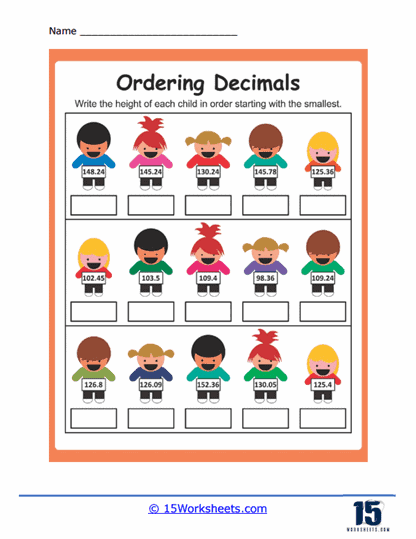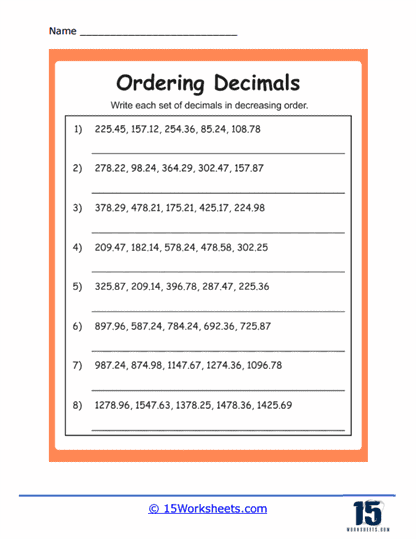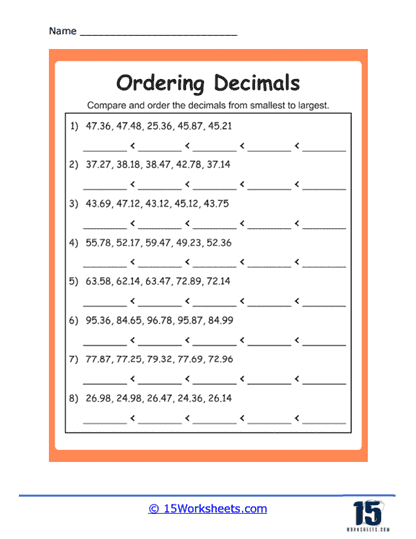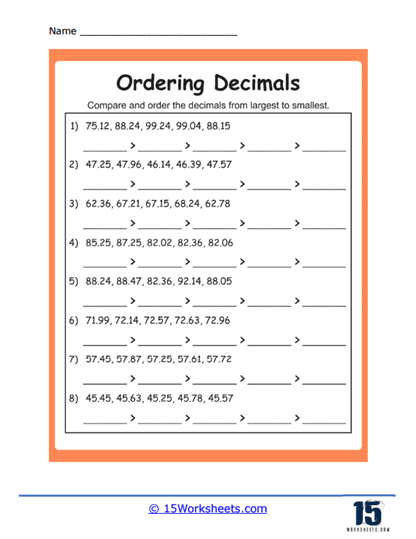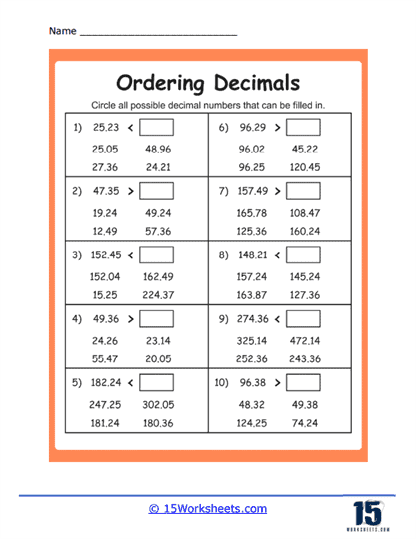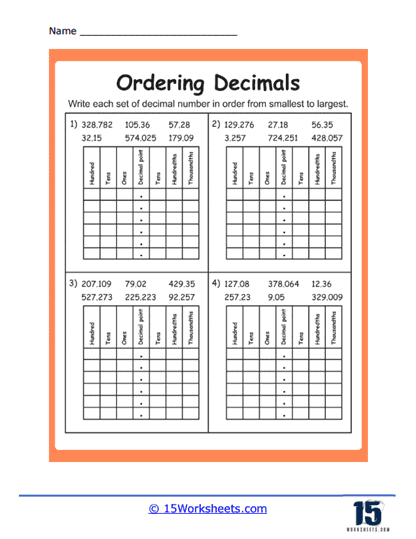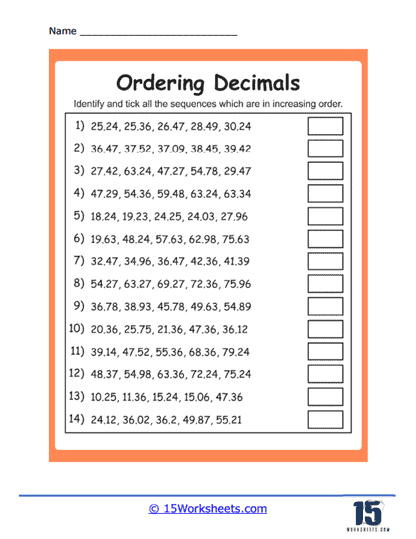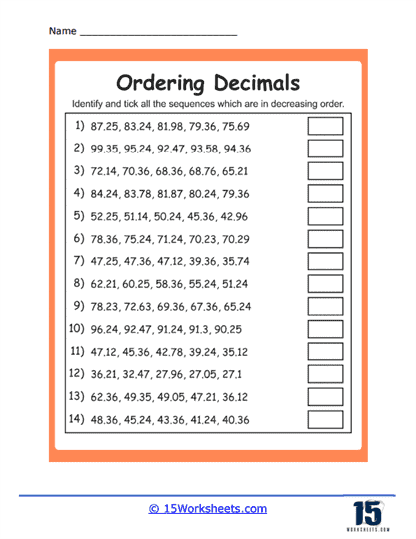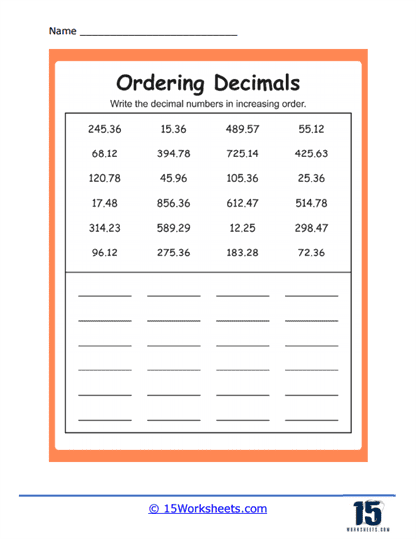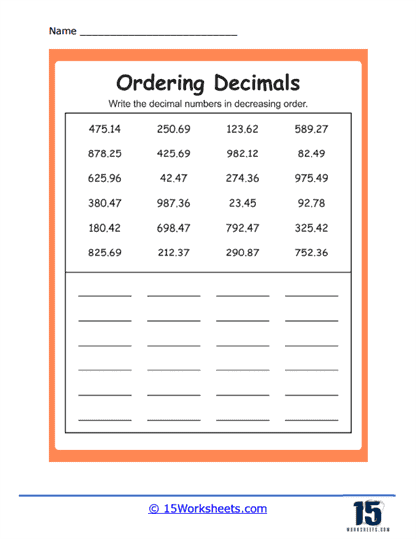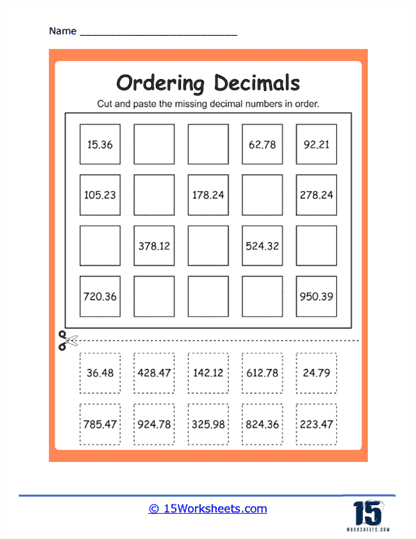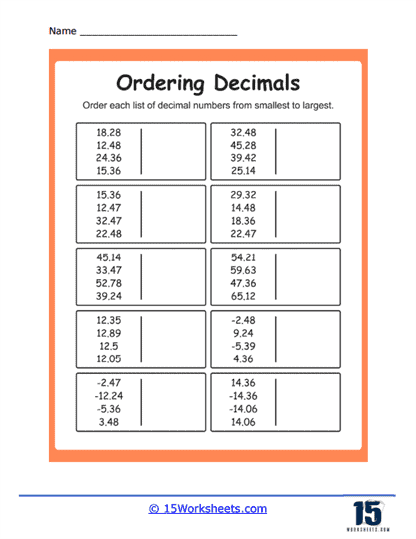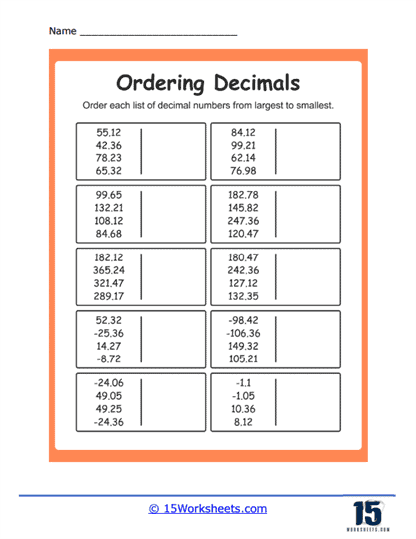Ordering Decimals Worksheets
About These 15 Worksheets
These worksheets will reinforce the concept of arranging decimal numbers in a specific order, typically from least to greatest (ascending order) or from greatest to least (descending order). The primary objective of these worksheets is to help students understand the relative size of decimal numbers and their positions within the number system.
These worksheets contain a wide variety of exercises, each tailored to incrementally improve a student’s grasp on the topic. Here are some examples of the types of exercises you might find:
Simple Ordering – The basic exercise involves ordering a set of decimal numbers either in ascending or descending order. This is the fundamental type of problem and serves as the foundation for understanding this concept.
Comparing and Ordering – These exercises involve not only ordering the decimal numbers but also comparing them. These exercises often start with simple comparisons but can get more complex with larger or smaller decimal values.
Mixed Ordering – These problems involve ordering sets of numbers that include both whole numbers and decimal numbers. This is slightly more challenging as it requires understanding the relationship between whole numbers and decimal numbers.
Word Problems – These exercises involve real-world scenarios that require ordering decimals to solve. For example, a question might ask students to order objects by their decimal weights.
Ordering on a Number Line – In these exercises, students are given a series of decimals to plot on a number line. This provides a visual way to understand the order of decimals.
Working with Ordering Decimal Values worksheets can greatly enhance a student’s overall math skills:
Number Sense – Understanding the relative sizes of decimal numbers and how to arrange them in order enhances a student’s general number sense and comprehension of the number system.
Critical Thinking – Comparing and ordering decimal numbers requires logical reasoning and attention to detail, helping to develop critical thinking skills.
Problem-Solving – Word problems necessitate that students apply their knowledge to solve real-world problems, thereby improving problem-solving skills.
Confidence with Decimals – Regular practice with these worksheets can increase a student’s comfort level and confidence when working with decimal numbers.
The skill of ordering decimal values is highly practical and can be applied to a variety of real-life scenarios. For example, when shopping, you might compare prices of products (which are usually in decimal form) and arrange them from least expensive to most expensive. In a recipe, you might need to order the amounts of ingredients needed. When dealing with measurements (like distance, length, weight, etc.), understanding and ordering decimals can also be crucial. In essence, any scenario dealing with money or measurements often requires a solid understanding of decimal values.
How Do You Order Decimal Values Properly?
Arranging decimal numbers in ascending (increasing) or descending (decreasing) order involves understanding the value of each digit in a decimal number according to its place value. Here’s a detailed step-by-step guide on how to do it:
Understand the Decimal Place Value System – Before you begin, it’s important to understand the decimal place value system. Each digit in a decimal number has a value depending on its position relative to the decimal point. To the left of the decimal point, the place values are ones, tens, hundreds, and so on, moving left. To the right of the decimal point, the place values are tenths (0.1), hundredths (0.01), thousandths (0.001), and so forth, moving right.
Identify the Decimal Numbers – Write down or identify the list of decimal numbers you want to arrange. For instance, if you have the numbers 0.2, 0.12, 0.022, and 0.202.
Compare Whole Number Parts – Start by comparing the whole number parts of the decimal numbers, if they exist. In our example, all the numbers are less than one, so they have no whole number parts.
Compare Decimal Places from Left to Right – Next, compare the numbers from left to right, one decimal place at a time. Begin with the tenths place, then the hundredths place, and so on.
In our example, comparing the tenths place of each number gives us the order – 0.022 (2 in the tenths place), 0.12 (1 in the tenths place), 0.2 (2 in the tenths place), and 0.202 (2 in the tenths place). However, we have a tie between 0.022, 0.2, and 0.202, so we need to look at the hundredths place.
In the hundredths place, 0.2 has no digit (which we can think of as a zero), 0.202 has a zero, and 0.022 has a 2. This allows us to further order our numbers – 0.2 (0 in the hundredths place), 0.202 (0 in the hundredths place), 0.022 (2 in the hundredths place), and 0.12 (remains the same).
Once again, we have a tie between 0.2 and 0.202, so we go to the thousandths place. The number 0.202 has a 2 in the thousandths place, while 0.2 has no digit (or a zero).
Arrange in Ascending or Descending Order – With all the comparisons done, we can now arrange our numbers. For ascending order (least to greatest), the arrangement would be 0.2, 0.202, 0.022, 0.12. For descending order (greatest to least), we simply reverse this order to get 0.12, 0.022, 0.202, 0.2.

